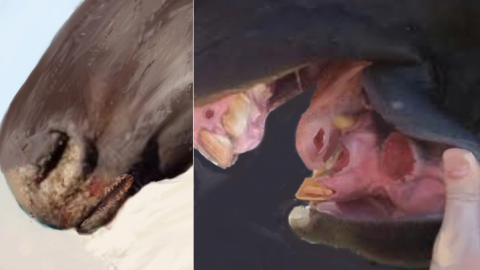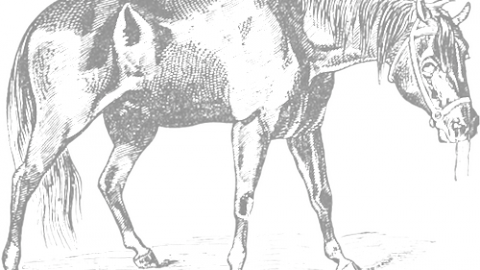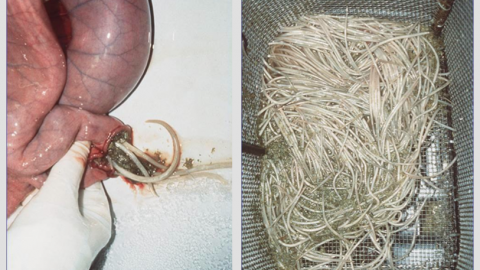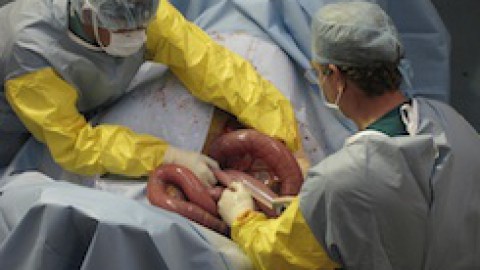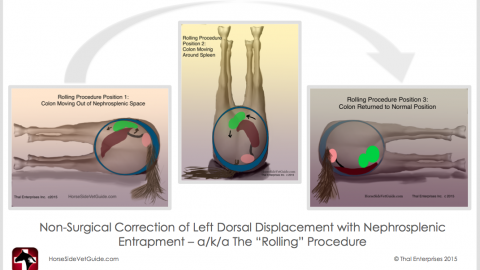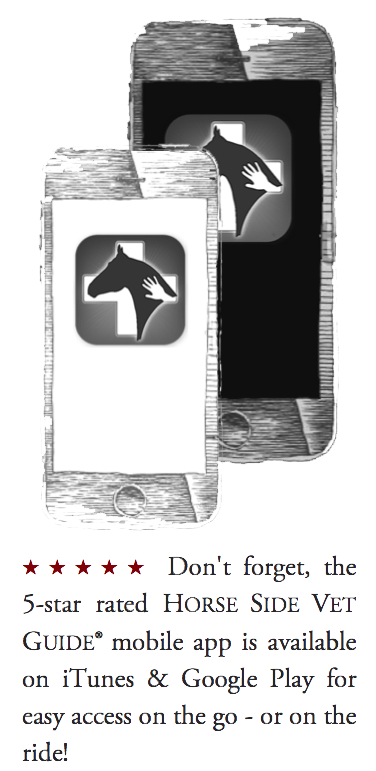Equine Colic (Abdominal Pain): Part II
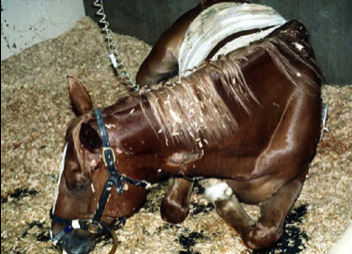
In Part 1 of this article, I discussed how colic is not a disease but a group of signs shown by a horse experiencing abdominal pain. The signs can range in severity from a subtle reduction in appetite to violent rolling or thrashing. I explained that abdominal pain (colic) could be caused by any number of conditions (“Conditions Causing Colic” or CCC’s) that affect any part of the equine gastrointestinal tract.
When a non-vet notices a horse in colic pain, they have no way to differentiate these conditions. The problem might be minor or it might be fatal. Some of the common, simple conditions (gas or spasm) often disappear with a little time and no treatment. These are the same simple conditions that will disappear if a horse is walked, given a trailer ride, or given “a little Banamine® or Buscopan®”.
A high percentage of horses showing signs of colic pain (with the simple CCC’s) resolve spontaneously. But if the pain is due to a true mechanical obstruction of the intestine (such as a displaced, twisted, or severely impacted intestine) the condition will worsen rapidly and can quickly result in death. These cases will require immediate veterinary intervention and possible intensive care or surgery. So when you see a horse in colic pain, you are faced with a situation that could go either way. For this reason, to reduce risk, it is best to contact your veterinarian at the first sign of any colic.
Horses showing signs of colic can be classified into the following groups:
-
Intestinal Dysfunction: 60-70% of horses showing colic signs have a “simple” colic (intestinal spasm, small accumulation of gas in the intestinal tract, mild impaction) and will resolve quickly with little or no medical treatment. A small number of these cases will require more intensive medical treatment.
-
Inflammation or Ulceration: Inflammation, irritation or damage to the inner lining of the various parts of the intestinal tract can cause colic signs. Examples include gastric and colonic ulcers, parasite damage, and intestinal infections.
-
Intestinal Accidents: This group of cases often requires emergency abdominal surgery, intensive care, or other aggressive veterinary treatment. Examples of these conditions include mechanical displacement or twist of the intestine, or entrapment of the intestine in a space it does not belong. More severe conditions can kill horses in a few hours. Fortunately, intestinal accidents only make up about 10% of colic episodes, but it is critical that these cases are identified early. Prompt diagnosis and correct treatment will make the difference between life and death.
Your Role
To be a knowledgeable equine caretaker, you need to know something about colic:
-
You should be able to identify the signs of colic.
-
You should understand that the equine gastrointestinal tract is complex and sensitive.
-
You should understand that there is a multitude of CCC’s.
-
You should understand the basic facts regarding colic surgery (including cost) and whether or not you would consider colic surgery for each of your individual horses if faced with that decision.
Beyond this basic knowledge, the most important thing to do when you identify colic is to call your veterinarian immediately, to alert them and to discuss the situation. Even though simple conditions may resolve spontaneously, it is best to start a dialog immediately.
Depending on the circumstances, your vet may want to see your horse immediately or may want you to observe for a period of time to see if the problem resolves on its own. There are a few things that you should almost always do when your horse is showing signs of colic:
-
Usually, you should remove all feed until intestinal function improves. How long feed needs to be withdrawn relates to the diagnosis and whether or not the horse has been given Banamine®.
-
Unless your vet advises otherwise, always provide access to fresh water.
-
Some hand walking may improve intestinal function and give your horse (and you) something else to think about. Excessive exercise is unnecessary and may stress the horse. If a painful horse will lie quietly, it is usually best to let them rest.
-
If a horse is trying to roll, it may be best to hand-walk them, but always keep your safety as the priority. Keep the distressed horse away from fences and barriers and away from onlookers.
-
Always keep the horse under close observation until the signs of colic resolve or as instructed by your veterinarian.
-
Use Banamine® (flunixin meglumine) only as directed by your vet. Keep in mind that it is NOT a “cure for colic” but is a pain-relieving drug and can mask signs of colic pain. It can lead you to believe that the condition has resolved when in fact it has not.
The message I send to my clients is: “I don’t need to see every horse that shows signs of colic, but I need to know about each one.” If you communicate with me, I can help you determine the ones that I do need to see. That will depend on the value of the horse (or your emotional attachment to the horse), your finances, and your tolerance for risk.
Your Veterinarian’s Role
Your vet’s role is to use physical examination and diagnostic tests to try to make a definitive diagnosis, or at least assign the case to one of the groups above as early as possible. An accurate diagnosis means appropriate treatment and accurate prognosis.
The veterinary examination of a horse showing colic starts with a careful history. Certain types of colic are more common in certain breeds, ages, and in one sex or the other. Veterinarians consider these factors as they consider the possibilities for the CCC. A careful history can provide other clues that can help a veterinarian make a diagnosis.
-
An important characteristic of a colic episode is the duration of pain, and responsiveness to pain relieving drugs. Certain conditions (large colon volvulus or twist for example) are known to be extremely painful.
-
Vital signs such as temperature, heart rate, gum color, and intestinal motility (movement) are evaluated and make up an important part of the picture.
-
Passage of a stomach tube gives valuable information about the function of the upper intestine and stomach, and may also be used to provide treatment with oral fluids and medications. A horse with blockage of the upper parts of the intestine may have accumulated fluid backed up under pressure in the stomach (horses cannot vomit) and this fluid may “reflux” from a tube placed into the stomach.
-
Rectal palpation is a valuable tool for diagnosis of horses with abdominal pain. In this procedure, a veterinarian feels the abdominal organs and specific regions of the intestine through the rectal wall. Examples of rectal exam findings include accumulations of feed, fluid or gas in specific segments, or incorrect location of a specific segment.
-
Abdominocentesis (belly tap) is sampling and analysis of the fluid that bathes the intestine. This procedure can give valuable information about the health of the affected intestine.
-
Abdominal ultrasound is an extremely useful tool for adding information to the examination. The size, shape, contents and movement of specific segments can be visualized.
-
Blood work and other diagnostics are used as needed to give additional information.
An experienced veterinarian quickly combines all the information gathered from the history, physical exam and diagnostic tests, and comes up with a likely diagnosis and a treatment plan. Treatment will depend on the specific condition suspected or diagnosed and might include medications for pain, oral and/or intravenous fluids, antibiotics, drugs to stimulate intestinal movement, ulcer medications, or laxatives, or enemas for foals.
Sometimes the examination and diagnostics suggest that emergency colic surgery is the best or only course of treatment. It is expensive and requires an extensive rehabilitation period. The prognosis depends on the specific condition diagnosed, and often this remains unknown until the abdomen is explored by the surgeon. In general, survival rates are much better than they were in the past. Many horse owners cannot afford these services in today’s economy and horse industry.
Your vet’s role is to try to diagnose what might be causing the colic pain in your horse, and then to provide you the diagnostic and treatment options and their costs. If your vet does not have the diagnostic experience or equipment to make a diagnosis, then they should offer you referral to someone who can. Once the problem has been resolved, it is their role to discuss management to reduce the likelihood of the problem in the future.
Management for Prevention of Colic
CCC’s cause more equine deaths each year than any other cause. The economic loss to the industry caused by CCC’s is second only to lameness. Why are CCC’s such a problem for domestic horses?
Domestic horses evolved from wild horses. Wild horses were constantly active, moving and grazing on coarse grasses throughout the day, eating small and frequent meals. Their intestine evolved to accommodate this lifestyle. Unlike wild horses, many modern horses are confined in small areas and fed one or two rich meals per day. This lifestyle change works against the structure and function of the equine intestine. Good management practices mimic the “wild horse state” as closely as practical. While conditions causing colic can affect even the most well managed horses, smart management is a key component of prevention.
It helps to consider colic “trigger factors” that are factors that may increase the likelihood of a CCC. Trigger factors include:
-
Rapid Change in Feed or Management
-
Stress, including Transport, Foaling or Weaning
-
Major Weather Changes
-
Stall Confinement
-
Parasitism
-
Sand Accumulation
I encourage all horse owners to do the following to minimize intestinal problems in their horses:
-
Make management and feeding changes gradually.
-
Establish a consistent feeding and management routine, and stick to it.
-
Provide frequent turnout or consistent exercise.
-
Provide access to fresh water at all times.
-
Feed multiple times during the day versus one big feeding. Consider the use of “Slow Feeders” that regulate the rate that a horse consumes hay.
-
Feed a good quality and consistent hay as the staple.
-
Keep the amount of grain fed to a minimum for the work the horse is doing.
-
Avoid sand accumulation by not feeding on sandy soils. Use a psyllium supplement if necessary.
-
Implement a veterinarian-approved parasite control program using fecal egg counts.
-
Pay particular attention to mares around foaling time and to those horses that have had colic signs before. Handle those horses very carefully, as they may be more sensitive to triggers.


